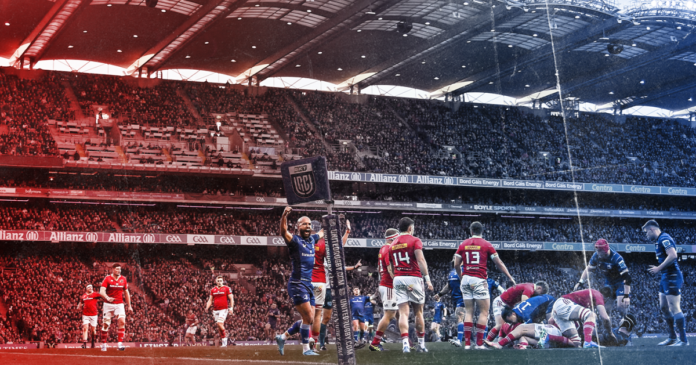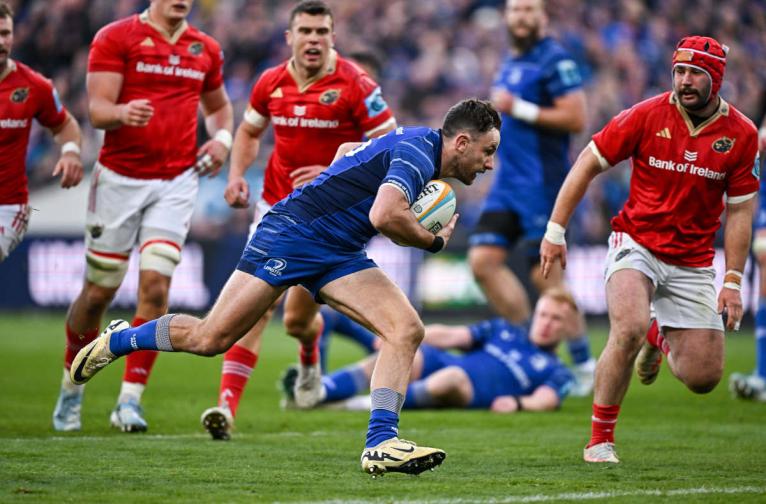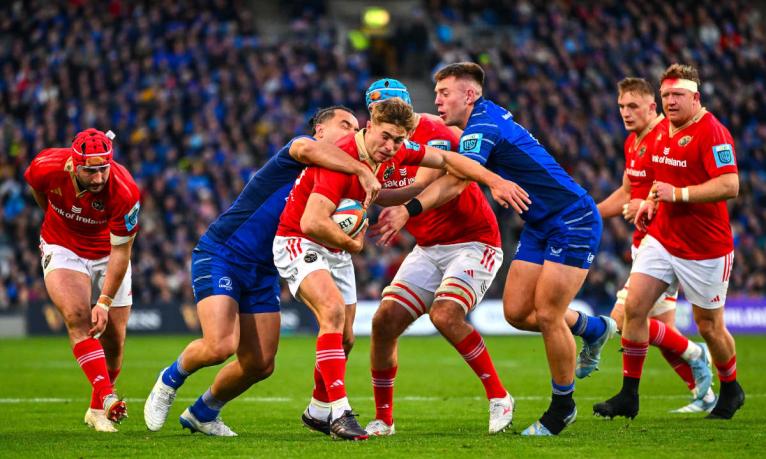
[ad_1]
Membership of the Croke Park club has become quite the thing in Irish rugby. There is an element of luck to it: if your career happens to coincide with the window opening to Ireland’s biggest and most storied stadium then you’re in with a chance; if not then it’s a box on your bucket list that will remain unticked. The value is not so much getting to trot out on a top quality track, but being part of a statement about the rude health of the game in this country. It’s the kind of PR that affects your bottom line.
This is for both domestic and foreign consumption. If you’re unfamiliar with the politics of sport in Ireland, then you’ll wonder why the local stuff is even an issue. Who cares whether Leinster play Munster in Dublin, Cork or Limerick? Why are the Irish still uptight about their stadia and who plays where and when?
RG Snyman scored one of Leinster’s four tries in his first game against his old Munster team-mates (Photo Sam Barnes/Sportsfile via Getty Images)
Mercifully, it has mellowed. To put it in perspective, Jarlath Burns, the president of the GAA (Gaelic Athletic Association) was being interviewed on national radio the day after Croke Park was packed for Leinster’s win over Munster. In a wide-ranging discussion about the state of Gaelic football, which tweaks its rules almost as often as rugby, the sign-off question was this: would he have any concerns for winning hearts and minds given the spectacle of a widely televised full house showing a non-GAA game?
“None whatsoever,” Burns said. “We work really well with the IRFU and FAI. They are two wonderful organisations and we had a fantastic match there yesterday (Saturday). We are very proud that we can make our stadium available for big games like that… because we know that everyone’s a winner there, including the GAA and including rugby.
Who else relative to Ireland’s size can put over 80,000 people through the turnstiles for a fixture outside the festive season, a game so early in the campaign it’s a country mile from the knockouts?
“In our 140th year in the GAA, it would be a terrible lack of confidence to start worrying about other games and other sports when in fact the biggest problem we have is not having enough pitches for people who want to play our games. We work really well with the other organisations and I can say as a school principal that we’re no longer in opposition with other sports. That’s not the way it works. Sporting life is in opposition to the sedentary lifestyle, to phones, to mobile devices, to children sitting on their beds on TikTok all day long. If I can get a child out playing sport – any sport – that’s the gateway to a healthier lifestyle.”
The idea of the different sporting codes being united in their battle to get kids off their backsides and away from their phones doesn’t paint the full picture though. The GAA, football and rugby are fishing in the same pond, and while between them their effect on the health and wellbeing of Ireland’s youth is a huge positive, ultimately they are in competition with each other.
 Hugo Keenan continued his successful return from Sevens by scoring Leinster’s third try at Croke Park (Photo Sam Barnes/Sportsfile via Getty Images)
Hugo Keenan continued his successful return from Sevens by scoring Leinster’s third try at Croke Park (Photo Sam Barnes/Sportsfile via Getty Images)
So, on the relatively few times rugby parks itself in GAA HQ, three things are required: the seats need to have bums on them; the product has to be high quality; if it’s an Irish team against out-of-towners then a home win is very good for business. All of these elements feed into the sales pitch for native Irish and the new Irish – those who have arrived here from overseas – to sign up to the game. It’s all a bonus.
The foreign affair is important too. Who else relative to Ireland’s size can put over 80,000 people through the turnstiles for a fixture outside the festive season, a game so early in the campaign it’s a country mile from the knockouts?
If twinning with dullsville in central Poland feels like a lifetime ago then reaching out to South Africa’s Highveld is very much in vogue for the new Ireland.
It is a real-time show of strength, and we should take this in tandem with what unfolded in Bloemfontein over the last fortnight. Back in the late 1990s, when Ireland were waking up to the relationship between physical fitness and winning Test matches, the IRFU latched onto the cryotherapy chambers of Spala in Poland as a staple in the diet. Spala, by any account, is not on anyone’s tourist trail, which brings us neatly to Bloem.
If twinning with dullsville in central Poland feels like a lifetime ago then reaching out to South Africa’s Highveld is very much in vogue for the new Ireland. The second mini-tour there in three seasons, competing in the Toyota Challenge, has just been completed with another clean sheet, another successful operation in exposing emerging Irish players to overseas opposition in trying circumstances i.e. it’s very hot and there is nothing to do there.
The tourists are looked after by the rump of the Ireland senior coaching crew. They arrive home with greater clarity around what’s required by those who lay the top table. You’d be delusional if you thought the Toyota Challenge was the acid test of who will make it and who won’t, but for sure it has some purpose. Already this item on the calendar has delivered more than initially projected, so you’d hope the IRFU are exploring other options in case it hits the buffers.
 Leinster hooker Lee Barron (in blue, right) showed up well in the absence of Dan Sheehan and Ronan Kelleher (Photo Shauna Clinton/Sportsfile via Getty Images)
Leinster hooker Lee Barron (in blue, right) showed up well in the absence of Dan Sheehan and Ronan Kelleher (Photo Shauna Clinton/Sportsfile via Getty Images)
The bigger picture currently, as Ireland prepare to turn the corner into a four-Test November programme kicking off with New Zealand on 8 November, presents a healthy vista: the four provinces are in the top eight of the URC, with Leinster in their usual spot at the top, and below that quartet is a group of young players all milling around looking for the next opening to the top tier.
One of them – hooker Gus McCarthy – is benefitting from the space that appears when two lads higher up the line are on the treatment table. With Dan Sheehan and Ronan Kelleher both unavailable, the Croke Park game saw Leinster start Lee Barron (aged 23) with McCarthy (21) coming on in the second half. For an Academy player to be getting this exposure so soon could have been traumatic, but McCarthy is making every second count. He looks like he has growth potential.
Given the interest in the game here now… the expectation is for more than a drip feed of top-quality players. That’s what pays the rental on bog days in Croke Park.
You’d imagine Rob Herring will have regained fitness in good time for November, and with Dave Heffernan rejuvenated in Connacht, that pair will be in pole position to fill the huge hole left by Sheehan and Kelleher. But it would be worth asking your local bookmaker for a price on maybe Lee Barron getting capped against Fiji.
If that happens it will be another addition to the stock of hookers across the land, a bounty compared to the reserves at prop. It remains the slowest horse in the Irish field, and of the six who went to South Africa with Emerging Ireland in 2022 – Michael Milne looked the best prospect by a distance – none are romping onto Andy Farrell’s race card.
Rather there is a decent line-up of solid citizens. Given the interest in the game here now, and the return to the top of the world rankings thanks to South Africa’s defeat by Argentina last month, the expectation is for more than a drip feed of top-quality players. That’s what pays the rental on bog days in Croke Park.
[ad_2]
Copyright for syndicated content belongs to the linked Source link

